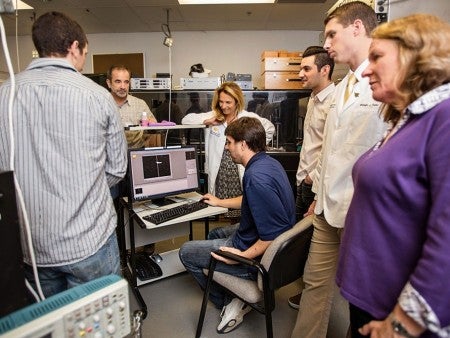The joint UCF project is called RIBOP – Research Initiative In Biophotonics – and was initiated after both colleges and the UCF Office of Research and Commercialization each contributed $15,000 to identify biological applications for photonics and lasers. The first team of researchers to receive RIBOP funding is Drs. Cristina Fernandez-Valle, a professor in the College of Medicine’s Burnett School of Biomedical Sciences, and Dr. Aristide Dogariu a professor at CREOL. So far they have published one paper and are now applying for a National Institutes of Health grant to continue their work.
“When you put people with different specialties and skills together, you never know what’s going to happen,” said Dr. Fernandez-Valle. “It’s a great opportunity to jump-start ideas.”
Dr. Fernandez-Valle’s research focus is on Neurofibromatosis type 2 (NF2), a disease that can leave children and young adults deaf, partially paralyzed or brain damaged. NF2 affects one in every 20,000 people, causing multiple tumors that, while benign, cause serious neurological problems. The disease attacks the body’s Schwann cells, which are cells in nerves in the body that form myelin sheaths around axons. Dr. Fernandez-Valle’s research is dedicated to understanding the cellular changes that make NF2 occur and targeting therapies that can prevent or slow tumor growth.
The team is developing novel photonic imaging techniques that allow them to observe how Schwann cells move on cylindrical axons. Imaging cells that move along curved surfaces is very difficult and therefore is poorly understood. All cells move during development, but if movement goes haywire, birth defects can occur and abnormal movement of cancer cells is part of the metastatic process by which cancers spread. By understanding Schwann cell movement, scientists hope to understand both how the Schwann cells form myelin and what happens when they acquire mutations and form tumors.
The partnership includes students at all levels who are learning their own lessons in collaborative thinking and interdisciplinary research. Dr. Fernandez-Valle’s students, Anthony Cole, a National Merit Scholar undergraduate, and Nicklaus Sparrow, a graduate student in Biomedical Sciences, work closely with Dr. Dogariu and his graduate students, Kyle Douglas and Colin Constant. A second-year M.D. student, William Trudo, was a Burnett School undergraduate and is doing his Focused Inquiry and Research Experience (FIRE) project with Dr. Fernandez-Valle on the optics and photonics project. He says working the collaboration has “pushed me out of my comfort zone. The use of light and lasers is outside what we generally learn in biology. Each of us has a different point of view and once you understand each other, you can move quickly.”
“I am a big picture person,” William said. “I’m always asking why.” By working with CREOL, he says, “the whole picture comes together.”
New discoveries are expected at the boundaries between traditional disciplines, a fact also realized by federal research agencies which are now increasingly looking to support more collaborative research projects. As Dr. Dogariu said, multidisciplinary projects like RIBOP “expand the range of what we can do through partnerships.”
